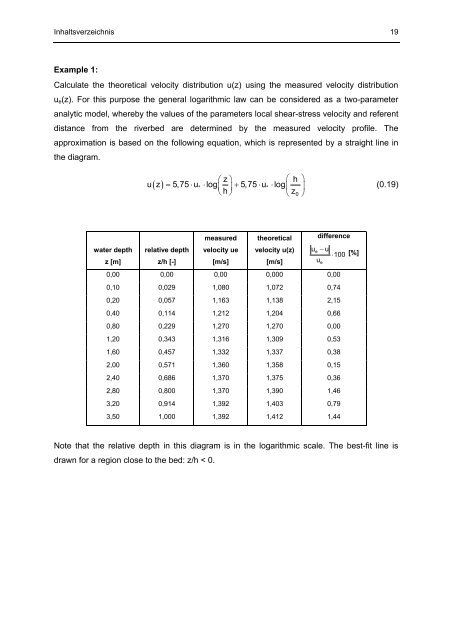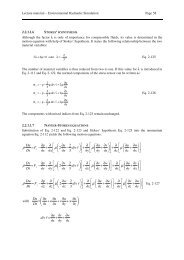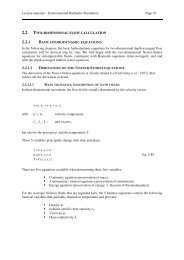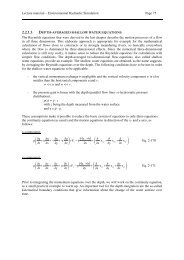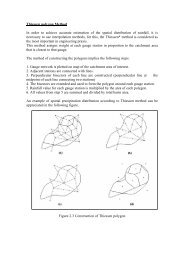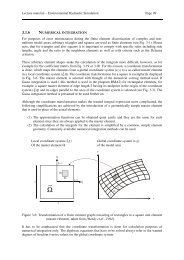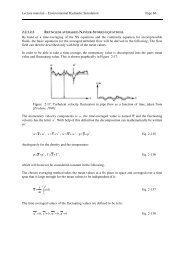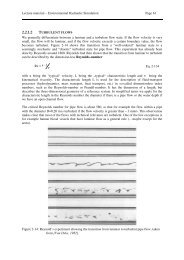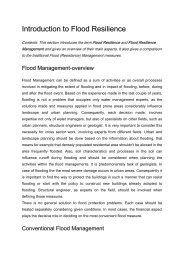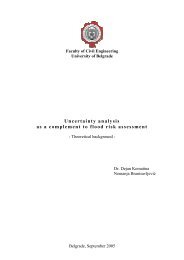Example 1: Calculate the theoretical velocity distribution u(z) using ...
Example 1: Calculate the theoretical velocity distribution u(z) using ...
Example 1: Calculate the theoretical velocity distribution u(z) using ...
You also want an ePaper? Increase the reach of your titles
YUMPU automatically turns print PDFs into web optimized ePapers that Google loves.
Inhaltsverzeichnis 19<br />
<strong>Example</strong> 1:<br />
<strong>Calculate</strong> <strong>the</strong> <strong>the</strong>oretical <strong>velocity</strong> <strong>distribution</strong> u(z) <strong>using</strong> <strong>the</strong> measured <strong>velocity</strong> <strong>distribution</strong><br />
u e (z). For this purpose <strong>the</strong> general logarithmic law can be considered as a two-parameter<br />
analytic model, whereby <strong>the</strong> values of <strong>the</strong> parameters local shear-stress <strong>velocity</strong> and referent<br />
distance from <strong>the</strong> riverbed are determined by <strong>the</strong> measured <strong>velocity</strong> profile. The<br />
approximation is based on <strong>the</strong> following equation, which is represented by a straight line in<br />
<strong>the</strong> diagram.<br />
⎛z⎞<br />
⎛ h ⎞<br />
u( z)<br />
= 5,75 ⋅u* ⋅ log⎜<br />
⎟+ 5,75 ⋅u*<br />
⋅log⎜ ⎟<br />
⎝h⎠ ⎝z0<br />
⎠<br />
(0.19)<br />
measured <strong>the</strong>oretical<br />
water depth relative depth <strong>velocity</strong> ue <strong>velocity</strong> u(z)<br />
z [m]<br />
z/h [-]<br />
[m/s]<br />
[m/s]<br />
difference<br />
ue<br />
− u<br />
⋅ 100 [%]<br />
u<br />
0,00 0,00 0,00 0,000 0,00<br />
0,10 0,029 1,080 1,072 0,74<br />
0,20 0,057 1,163 1,138 2,15<br />
0,40 0,114 1,212 1,204 0,66<br />
0,80 0,229 1,270 1,270 0,00<br />
1,20 0,343 1,316 1,309 0,53<br />
1,60 0,457 1,332 1,337 0,38<br />
2,00 0,571 1,360 1,358 0,15<br />
2,40 0,686 1,370 1,375 0,36<br />
2,80 0,800 1,370 1,390 1,46<br />
3,20 0,914 1,392 1,403 0,79<br />
3,50 1,000 1,392 1,412 1,44<br />
e<br />
Note that <strong>the</strong> relative depth in this diagram is in <strong>the</strong> logarithmic scale. The best-fit line is<br />
drawn for a region close to <strong>the</strong> bed: z/h < 0.
20 Inhaltsverzeichnis
Inhaltsverzeichnis 21<br />
Solution 1:<br />
Two characteristic values u(z/h) are determined:<br />
⎛z<br />
⎞<br />
⎛ h ⎞<br />
u⎜<br />
= 1⎟<br />
= 0,0+ 5,75⋅u* ⋅ log⎜<br />
⎟ = u1<br />
= 1,41m/s<br />
⎝h<br />
⎠ ⎝z0<br />
⎠<br />
⎛z<br />
⎞<br />
⎛ h ⎞<br />
u⎜<br />
= 0,1⎟<br />
= −5,75 ⋅ u* + 5,75 ⋅u* ⋅ log⎜<br />
⎟ = u2<br />
= 1,19 m / s<br />
⎝h<br />
⎠ ⎝z0<br />
⎠<br />
By <strong>the</strong> subtraction of <strong>the</strong> second equation from <strong>the</strong> first one, <strong>the</strong> expression in order to<br />
calculate <strong>the</strong> value of <strong>the</strong> local shear <strong>velocity</strong> is derived:<br />
u<br />
*<br />
u1 − u2<br />
= = 0,038 m/s<br />
5,75<br />
The calculation of <strong>the</strong> distance from <strong>the</strong> referent distance yields to:<br />
u<br />
− 1<br />
5,75⋅u<br />
−6<br />
z = h⋅ 10<br />
*<br />
= 1,4⋅10 m<br />
0<br />
The calculated <strong>velocity</strong> <strong>distribution</strong> is graphically represented<br />
The relative differences between <strong>the</strong> <strong>the</strong>oretical and empirical <strong>velocity</strong> <strong>distribution</strong>s are given<br />
in <strong>the</strong> last column of Table 1. The best match appears near <strong>the</strong> bed, whereas errors increase<br />
towards <strong>the</strong> free-surface, as expected.


